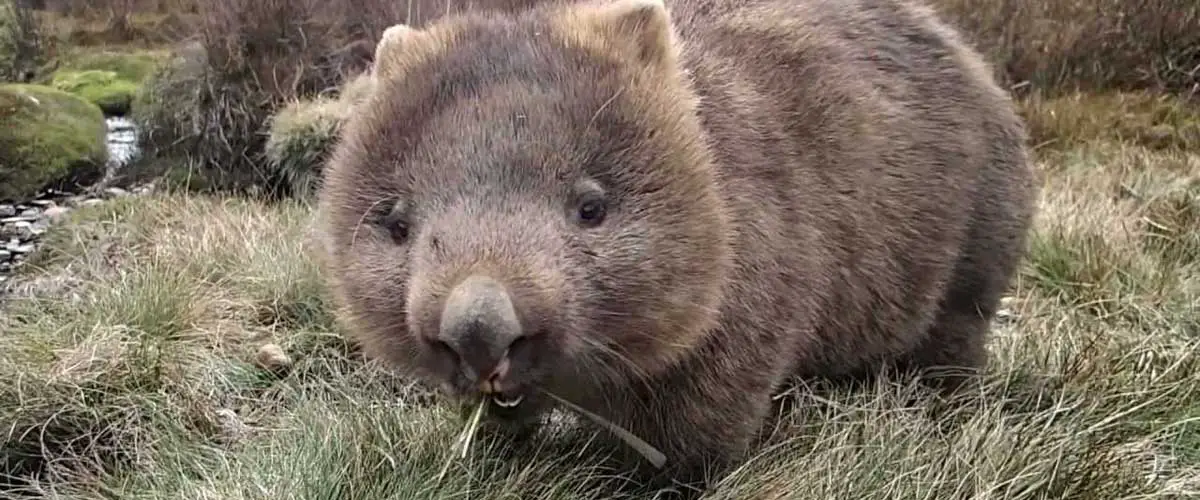Wombats are Australian marsupials found in forested, mountainous and heathland areas of south-eastern Australia and Tasmania. The name wombat comes from the Eora Aboriginal community who were the original inhabitants of the Sydney area.
Though wombats are not as abundant as they used to be, there are still plenty of them about and can often be seen if you are prepared to leave built up areas and enter into their territory. Wombats do wander across roads from time to time, so it is always a good idea to keep an eye out for them, particularly if driving through grasslands and woodlands.
Be aware that humans who accidentally find themselves in an affray with a wombat may find it best to scale a tree until the animal calms and leaves. Humans can receive puncture wounds from wombat claws as well as bites. Startled wombats can also charge humans and bowl them over, with the attendant risks of broken bones from the fall.
On occasions wombats have been awkwardly tamed in a captive situation, and even coaxed into being patted and held, possibly becoming quite friendly. However, their lack of fear means that they may display acts of aggression if provoked, or if they are simply in a bad mood. Its sheer weight makes a charging wild wombat capable of knocking an average-sized adult over, and their sharp teeth and powerful jaws can result in severe wounds. One naturalist, Harry Frauca, once received a bite 2 cm deep into the flesh of his leg – through a rubber boot, trousers and thick woollen socks.
Most wildlife park and sanctuaries parks, zoos and other tourist set-ups across Australia have wombats on public display, and they are quite popular.
Southern hairy-nosed wombats inhabit the semi-arid and arid grasslands and woodlands that receive 200 to 500 mm of rain per year in southeastern Western Australia, southern South Australia, and south-western New South Wales. They are the smallest wombats.
Northern hairy-nosed wombats used to be abundant in New South Wales until the settlement of Europeans in the area, but have been rarely seen after 1872. The sole population of the hairy-nosed wombat is now in the Epping Forest National Park, northwest of Clermont in Central Queensland.
The common (coarse-haired) wombat inhabits the hilly or mountainous coastal country of southeastern South Australia and as well, Tasmania and Flinders Island in Bass Strait. It used to occupy the other islands of Bass Strait, however, through hunting of humans, it has become extinct.

Wombats are stocky, robust animals, with a lot of power for digging. The body is close to one meter long with short, powerful legs. Wombats’ fur colour can vary from a sandy colour to brown, or from grey to black. All three known extant species of wombats average around 1 m in length and between 20 and 35 kg in weight.
Wombats have an extraordinarily slow metabolism, taking around 14 days to complete digestion, which aids their survival in arid conditions. They generally move slowly, and because of this are known for taking shortcuts, but when threatened they can reach up to 40 km/h and maintain that speed for up to 90 seconds. Wombats defend home territories centred on their burrows, and react aggressively to intruders. The common wombat occupies a range of up to 23 ha, while the hairy-nosed species have much smaller ranges, of no more than 4 ha.
Wombats dig extensive burrow systems with rodent-like front teeth and powerful claws. One distinctive adaptation of wombats is their backwards pouch. The advantage of a backwards-facing pouch is that when digging, the wombat does not gather dirt in its pouch over its young.
Although mainly crepuscular and nocturnal, wombats will also venture out to feed on cool or overcast days. They are not commonly seen, but leave ample evidence of their passage, treating fences as minor inconveniences to be gone through or under, and leaving distinctive cubic faeces.
Wombats are herbivores; their diet consists mostly of grasses, sedges, herbs, bark and roots. Their incisor teeth somewhat resemble those of the placental rodents, being adapted for gnawing tough vegetation. Like many other herbivorous mammals, they have a large diastema between the incisors and the cheek teeth, which are relatively simple.
Southern hairy-nosed wombats have withstood massive habitat loss due to human clearing of land. They are considered threatened, but are not listed as an endangered species (Cronin, 2000). Currently, one of the main threats to their survival is the spread of rabbits throughout Australia. Rabbits, and domestic livestock, compete with wombats for forage, leading to over grazing in many areas.
The decline of the common wombat has resulted from humans exterminating them, hunting for sport, and competition for food with rabbits. Each species of wombat is protected to some degree in the different states in Australia, except in Victoria, where they are still threatened by hunting.
Northern hairy-nosed wombats are extremely endangered and there have been massive efforts to prevent their extinction. Although previously avoided at almost all costs, trapping has now become a major tool for conservationists to build up this population of wombats.










